Exploring Challenges Faced by Nepalese Female Students in Sydney
VerifiedAdded on 2022/11/11
|18
|4188
|5
Report
AI Summary
This report explores the key problems and challenges faced by Nepalese international female students at Holmes Institute in Sydney, Australia. It begins with an introduction highlighting the rich education culture of Australia and the significant Nepalese international student population. The research methodology section details the deductive research approach, positivism philosophy, and descriptive research design employed, along with the quantitative research method and the use of a questionnaire with Likert scales. The report outlines the research hypotheses, sampling technique (simple random sampling with a sample size of 50), questionnaire design, data collection process, and ethical considerations. The questionnaire covers demographic information, socio-cultural, financial, language barriers, teaching patterns, homesickness, social media, and part-time work. The report aims to provide recommendations for addressing the challenges faced by these students, including financial difficulties, socio-cultural adjustments, language barriers, homesickness, and differences in teaching patterns. This report provides valuable insights into the experiences of Nepalese female international students and offers potential solutions to improve their academic journey.
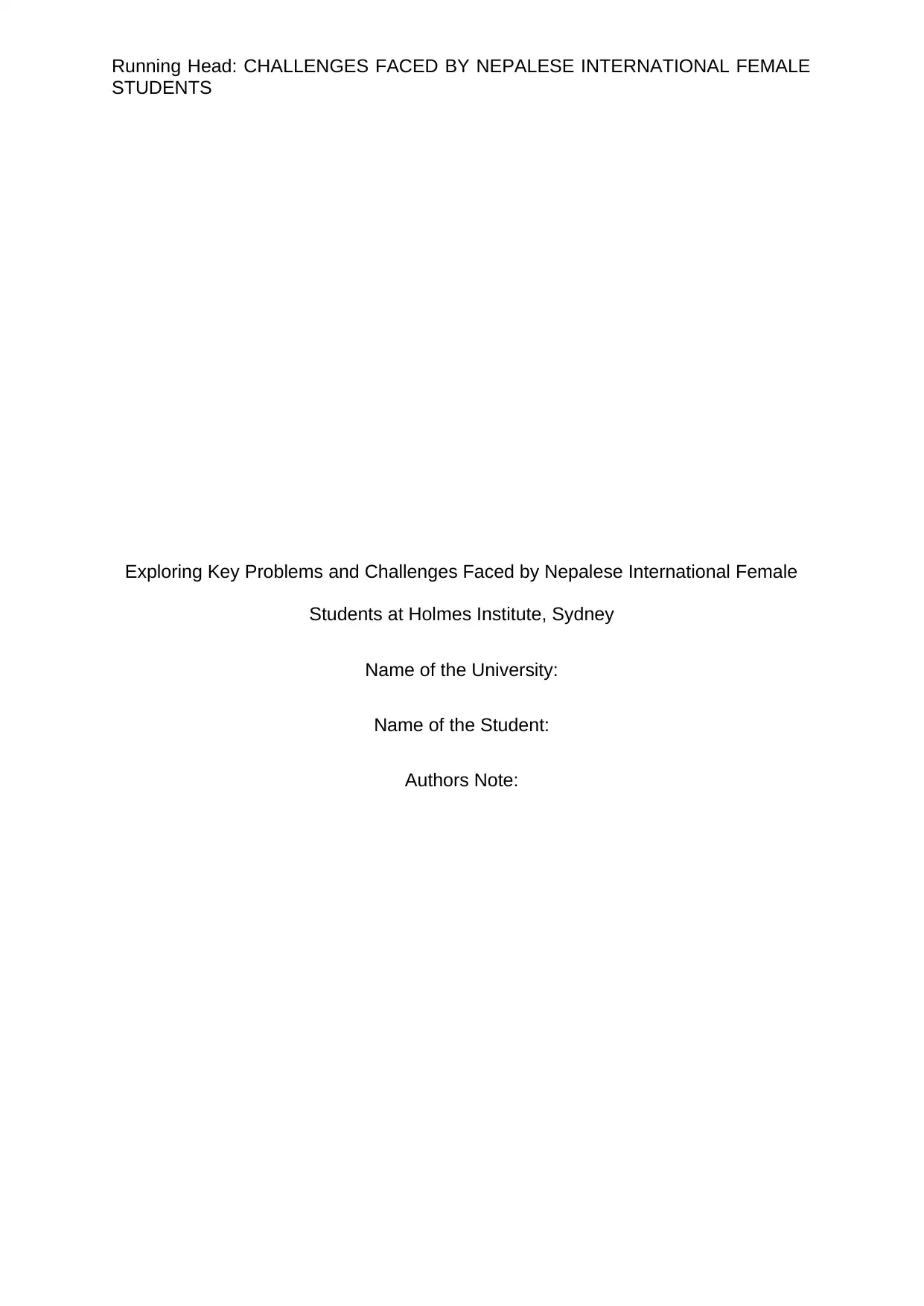
Running Head: CHALLENGES FACED BY NEPALESE INTERNATIONAL FEMALE
STUDENTS
Exploring Key Problems and Challenges Faced by Nepalese International Female
Students at Holmes Institute, Sydney
Name of the University:
Name of the Student:
Authors Note:
STUDENTS
Exploring Key Problems and Challenges Faced by Nepalese International Female
Students at Holmes Institute, Sydney
Name of the University:
Name of the Student:
Authors Note:
Paraphrase This Document
Need a fresh take? Get an instant paraphrase of this document with our AI Paraphraser
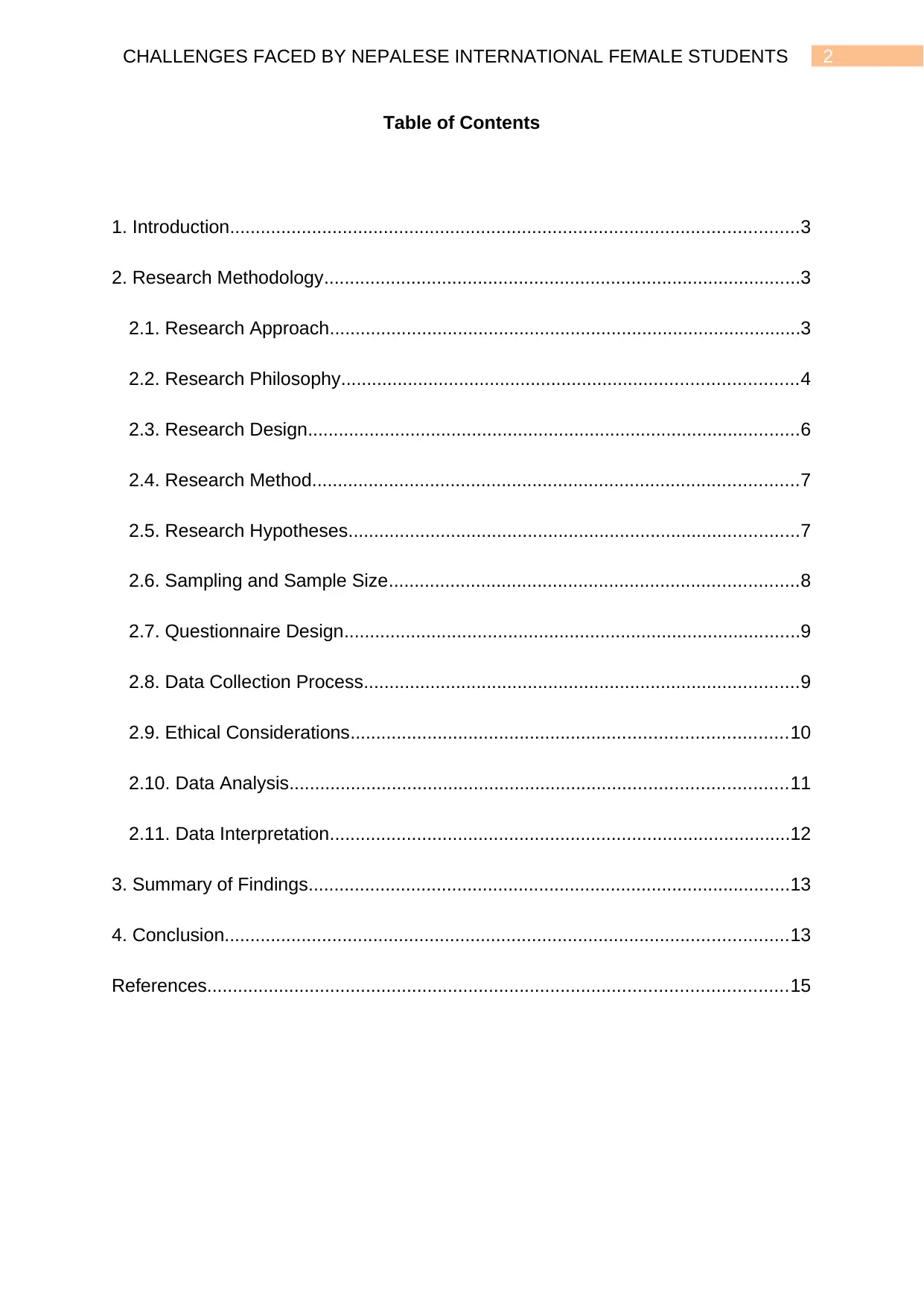
2CHALLENGES FACED BY NEPALESE INTERNATIONAL FEMALE STUDENTS
Table of Contents
1. Introduction...............................................................................................................3
2. Research Methodology.............................................................................................3
2.1. Research Approach............................................................................................3
2.2. Research Philosophy.........................................................................................4
2.3. Research Design................................................................................................6
2.4. Research Method...............................................................................................7
2.5. Research Hypotheses........................................................................................7
2.6. Sampling and Sample Size................................................................................8
2.7. Questionnaire Design.........................................................................................9
2.8. Data Collection Process.....................................................................................9
2.9. Ethical Considerations.....................................................................................10
2.10. Data Analysis.................................................................................................11
2.11. Data Interpretation..........................................................................................12
3. Summary of Findings..............................................................................................13
4. Conclusion..............................................................................................................13
References.................................................................................................................15
Table of Contents
1. Introduction...............................................................................................................3
2. Research Methodology.............................................................................................3
2.1. Research Approach............................................................................................3
2.2. Research Philosophy.........................................................................................4
2.3. Research Design................................................................................................6
2.4. Research Method...............................................................................................7
2.5. Research Hypotheses........................................................................................7
2.6. Sampling and Sample Size................................................................................8
2.7. Questionnaire Design.........................................................................................9
2.8. Data Collection Process.....................................................................................9
2.9. Ethical Considerations.....................................................................................10
2.10. Data Analysis.................................................................................................11
2.11. Data Interpretation..........................................................................................12
3. Summary of Findings..............................................................................................13
4. Conclusion..............................................................................................................13
References.................................................................................................................15
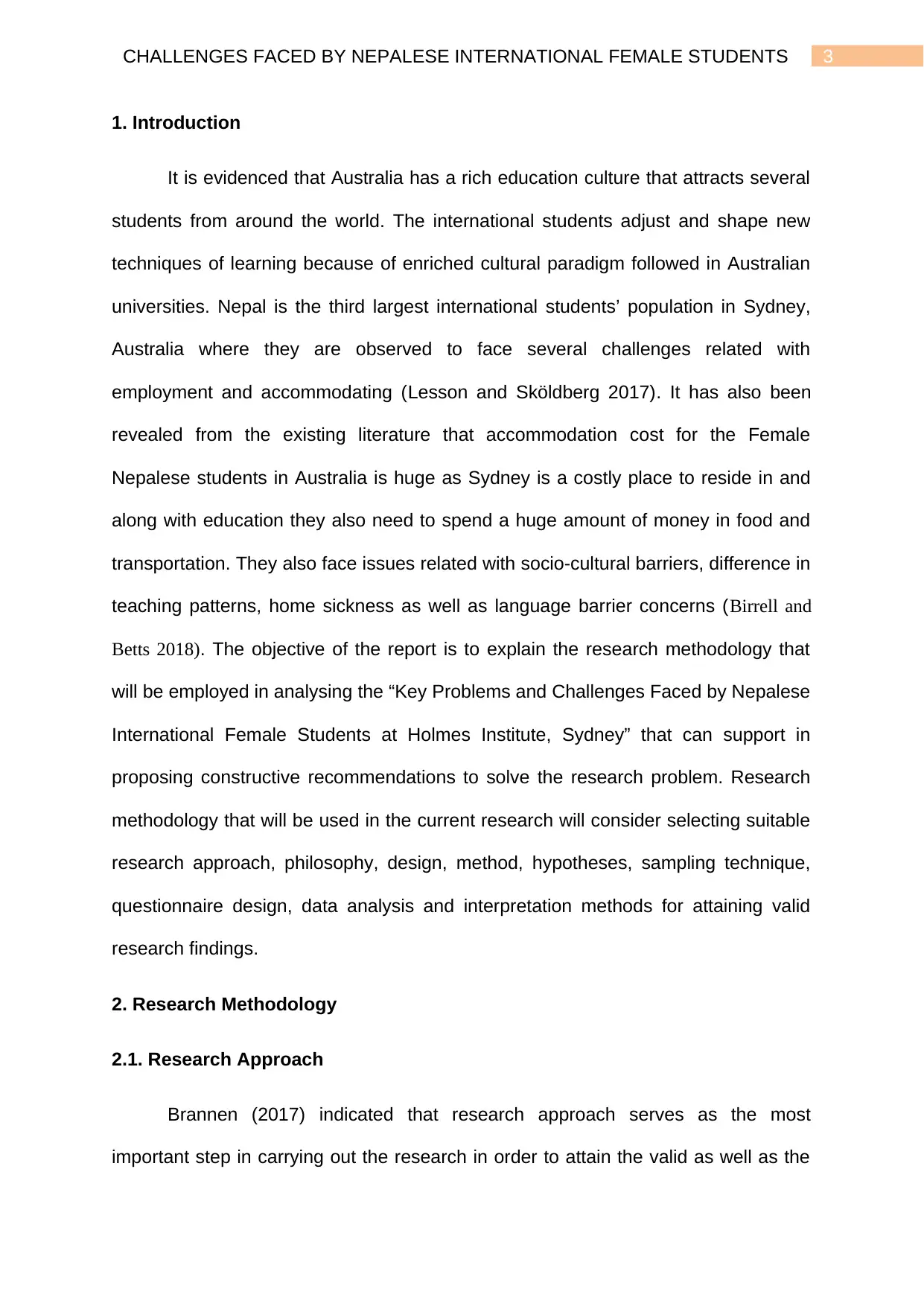
3CHALLENGES FACED BY NEPALESE INTERNATIONAL FEMALE STUDENTS
1. Introduction
It is evidenced that Australia has a rich education culture that attracts several
students from around the world. The international students adjust and shape new
techniques of learning because of enriched cultural paradigm followed in Australian
universities. Nepal is the third largest international students’ population in Sydney,
Australia where they are observed to face several challenges related with
employment and accommodating (Lesson and Sköldberg 2017). It has also been
revealed from the existing literature that accommodation cost for the Female
Nepalese students in Australia is huge as Sydney is a costly place to reside in and
along with education they also need to spend a huge amount of money in food and
transportation. They also face issues related with socio-cultural barriers, difference in
teaching patterns, home sickness as well as language barrier concerns (Birrell and
Betts 2018). The objective of the report is to explain the research methodology that
will be employed in analysing the “Key Problems and Challenges Faced by Nepalese
International Female Students at Holmes Institute, Sydney” that can support in
proposing constructive recommendations to solve the research problem. Research
methodology that will be used in the current research will consider selecting suitable
research approach, philosophy, design, method, hypotheses, sampling technique,
questionnaire design, data analysis and interpretation methods for attaining valid
research findings.
2. Research Methodology
2.1. Research Approach
Brannen (2017) indicated that research approach serves as the most
important step in carrying out the research in order to attain the valid as well as the
1. Introduction
It is evidenced that Australia has a rich education culture that attracts several
students from around the world. The international students adjust and shape new
techniques of learning because of enriched cultural paradigm followed in Australian
universities. Nepal is the third largest international students’ population in Sydney,
Australia where they are observed to face several challenges related with
employment and accommodating (Lesson and Sköldberg 2017). It has also been
revealed from the existing literature that accommodation cost for the Female
Nepalese students in Australia is huge as Sydney is a costly place to reside in and
along with education they also need to spend a huge amount of money in food and
transportation. They also face issues related with socio-cultural barriers, difference in
teaching patterns, home sickness as well as language barrier concerns (Birrell and
Betts 2018). The objective of the report is to explain the research methodology that
will be employed in analysing the “Key Problems and Challenges Faced by Nepalese
International Female Students at Holmes Institute, Sydney” that can support in
proposing constructive recommendations to solve the research problem. Research
methodology that will be used in the current research will consider selecting suitable
research approach, philosophy, design, method, hypotheses, sampling technique,
questionnaire design, data analysis and interpretation methods for attaining valid
research findings.
2. Research Methodology
2.1. Research Approach
Brannen (2017) indicated that research approach serves as the most
important step in carrying out the research in order to attain the valid as well as the
⊘ This is a preview!⊘
Do you want full access?
Subscribe today to unlock all pages.

Trusted by 1+ million students worldwide
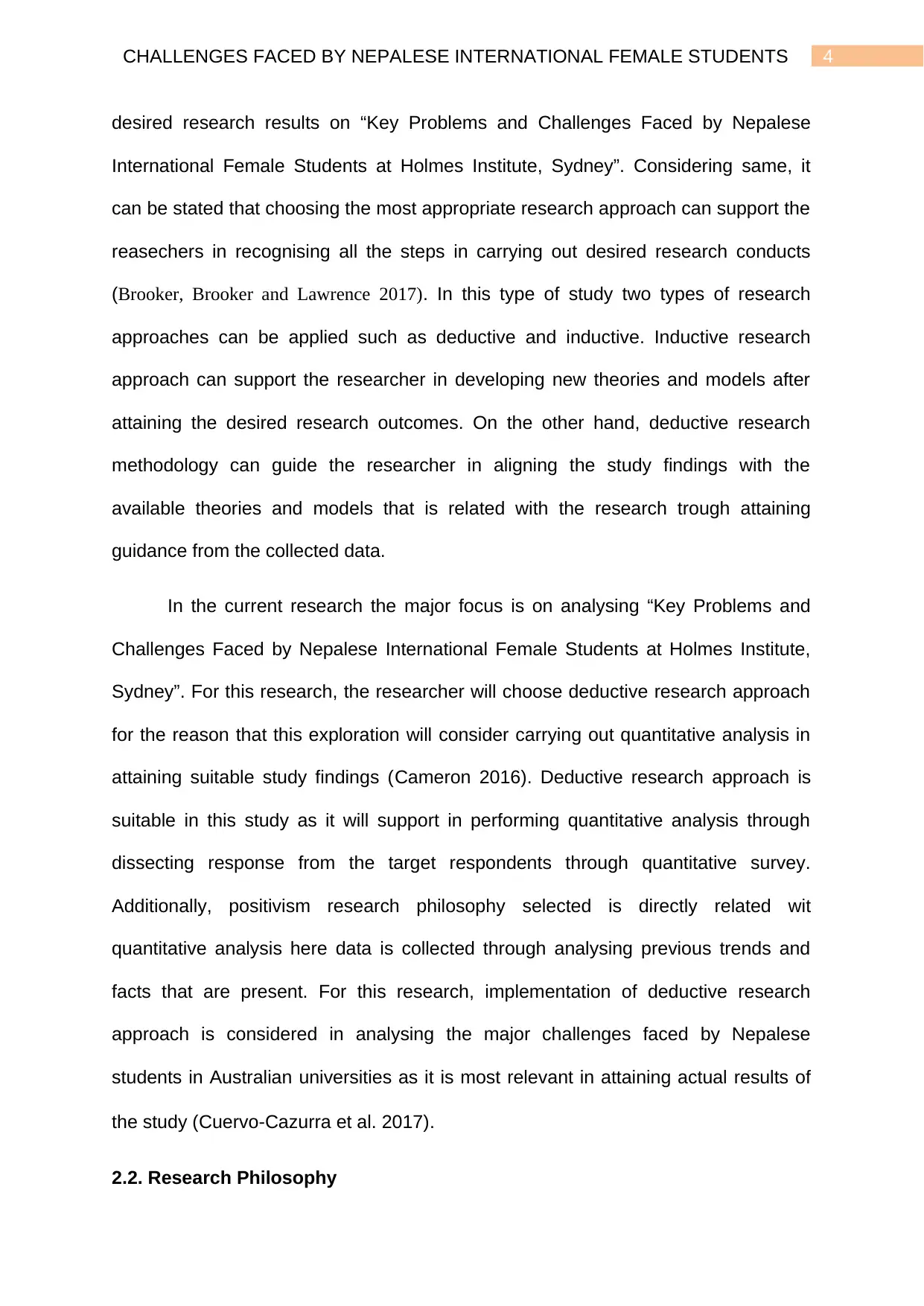
4CHALLENGES FACED BY NEPALESE INTERNATIONAL FEMALE STUDENTS
desired research results on “Key Problems and Challenges Faced by Nepalese
International Female Students at Holmes Institute, Sydney”. Considering same, it
can be stated that choosing the most appropriate research approach can support the
reasechers in recognising all the steps in carrying out desired research conducts
(Brooker, Brooker and Lawrence 2017). In this type of study two types of research
approaches can be applied such as deductive and inductive. Inductive research
approach can support the researcher in developing new theories and models after
attaining the desired research outcomes. On the other hand, deductive research
methodology can guide the researcher in aligning the study findings with the
available theories and models that is related with the research trough attaining
guidance from the collected data.
In the current research the major focus is on analysing “Key Problems and
Challenges Faced by Nepalese International Female Students at Holmes Institute,
Sydney”. For this research, the researcher will choose deductive research approach
for the reason that this exploration will consider carrying out quantitative analysis in
attaining suitable study findings (Cameron 2016). Deductive research approach is
suitable in this study as it will support in performing quantitative analysis through
dissecting response from the target respondents through quantitative survey.
Additionally, positivism research philosophy selected is directly related wit
quantitative analysis here data is collected through analysing previous trends and
facts that are present. For this research, implementation of deductive research
approach is considered in analysing the major challenges faced by Nepalese
students in Australian universities as it is most relevant in attaining actual results of
the study (Cuervo‐Cazurra et al. 2017).
2.2. Research Philosophy
desired research results on “Key Problems and Challenges Faced by Nepalese
International Female Students at Holmes Institute, Sydney”. Considering same, it
can be stated that choosing the most appropriate research approach can support the
reasechers in recognising all the steps in carrying out desired research conducts
(Brooker, Brooker and Lawrence 2017). In this type of study two types of research
approaches can be applied such as deductive and inductive. Inductive research
approach can support the researcher in developing new theories and models after
attaining the desired research outcomes. On the other hand, deductive research
methodology can guide the researcher in aligning the study findings with the
available theories and models that is related with the research trough attaining
guidance from the collected data.
In the current research the major focus is on analysing “Key Problems and
Challenges Faced by Nepalese International Female Students at Holmes Institute,
Sydney”. For this research, the researcher will choose deductive research approach
for the reason that this exploration will consider carrying out quantitative analysis in
attaining suitable study findings (Cameron 2016). Deductive research approach is
suitable in this study as it will support in performing quantitative analysis through
dissecting response from the target respondents through quantitative survey.
Additionally, positivism research philosophy selected is directly related wit
quantitative analysis here data is collected through analysing previous trends and
facts that are present. For this research, implementation of deductive research
approach is considered in analysing the major challenges faced by Nepalese
students in Australian universities as it is most relevant in attaining actual results of
the study (Cuervo‐Cazurra et al. 2017).
2.2. Research Philosophy
Paraphrase This Document
Need a fresh take? Get an instant paraphrase of this document with our AI Paraphraser
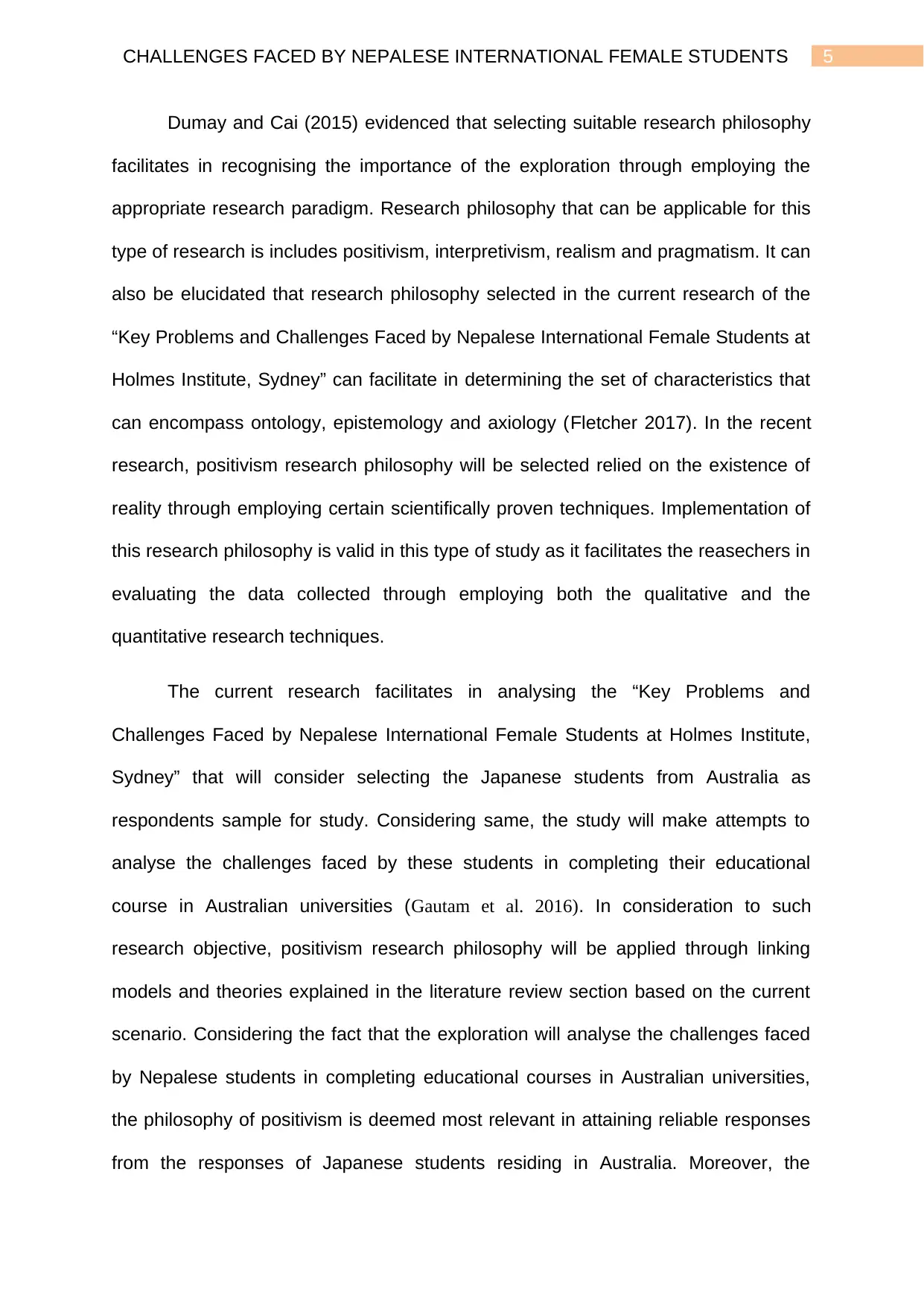
5CHALLENGES FACED BY NEPALESE INTERNATIONAL FEMALE STUDENTS
Dumay and Cai (2015) evidenced that selecting suitable research philosophy
facilitates in recognising the importance of the exploration through employing the
appropriate research paradigm. Research philosophy that can be applicable for this
type of research is includes positivism, interpretivism, realism and pragmatism. It can
also be elucidated that research philosophy selected in the current research of the
“Key Problems and Challenges Faced by Nepalese International Female Students at
Holmes Institute, Sydney” can facilitate in determining the set of characteristics that
can encompass ontology, epistemology and axiology (Fletcher 2017). In the recent
research, positivism research philosophy will be selected relied on the existence of
reality through employing certain scientifically proven techniques. Implementation of
this research philosophy is valid in this type of study as it facilitates the reasechers in
evaluating the data collected through employing both the qualitative and the
quantitative research techniques.
The current research facilitates in analysing the “Key Problems and
Challenges Faced by Nepalese International Female Students at Holmes Institute,
Sydney” that will consider selecting the Japanese students from Australia as
respondents sample for study. Considering same, the study will make attempts to
analyse the challenges faced by these students in completing their educational
course in Australian universities (Gautam et al. 2016). In consideration to such
research objective, positivism research philosophy will be applied through linking
models and theories explained in the literature review section based on the current
scenario. Considering the fact that the exploration will analyse the challenges faced
by Nepalese students in completing educational courses in Australian universities,
the philosophy of positivism is deemed most relevant in attaining reliable responses
from the responses of Japanese students residing in Australia. Moreover, the
Dumay and Cai (2015) evidenced that selecting suitable research philosophy
facilitates in recognising the importance of the exploration through employing the
appropriate research paradigm. Research philosophy that can be applicable for this
type of research is includes positivism, interpretivism, realism and pragmatism. It can
also be elucidated that research philosophy selected in the current research of the
“Key Problems and Challenges Faced by Nepalese International Female Students at
Holmes Institute, Sydney” can facilitate in determining the set of characteristics that
can encompass ontology, epistemology and axiology (Fletcher 2017). In the recent
research, positivism research philosophy will be selected relied on the existence of
reality through employing certain scientifically proven techniques. Implementation of
this research philosophy is valid in this type of study as it facilitates the reasechers in
evaluating the data collected through employing both the qualitative and the
quantitative research techniques.
The current research facilitates in analysing the “Key Problems and
Challenges Faced by Nepalese International Female Students at Holmes Institute,
Sydney” that will consider selecting the Japanese students from Australia as
respondents sample for study. Considering same, the study will make attempts to
analyse the challenges faced by these students in completing their educational
course in Australian universities (Gautam et al. 2016). In consideration to such
research objective, positivism research philosophy will be applied through linking
models and theories explained in the literature review section based on the current
scenario. Considering the fact that the exploration will analyse the challenges faced
by Nepalese students in completing educational courses in Australian universities,
the philosophy of positivism is deemed most relevant in attaining reliable responses
from the responses of Japanese students residing in Australia. Moreover, the

6CHALLENGES FACED BY NEPALESE INTERNATIONAL FEMALE STUDENTS
researcher did not consider employing other philosophies in this exploration as they
are not relied on the scientifically proven models as well as theories (Gerritsen 2016).
2.3. Research Design
In carrying out research on “Key Problems and Challenges Faced by
Nepalese International Female Students at Holmes Institute, Sydney”, suitable
research design will be schools that can provide the researcher with better
opportunity to guide the research in the direction of attaining the specified goal relied
on the research objectives (Ghimire and Maharjan 2015). Moreover, choosing the most
suitable research design can also facilitate the researcher in offering beer reference
through limiting the targeted study findings within which the remaining fraction of the
overall study is carried out on a predefined goal. In this type of study, the research
deigns that can be most appropriate includes exploratory, explanatory and
descriptive research design.
As this research has the focus on analysing the major challenges faced by the
Nepalese students of Australian universities through exploring the issues relation
with factors such as financial troubles, socio-cultural differences, language barriers,
homesickness and difference in teaching patterns, descriptive research design is
chosen (Hickson 2016). This research design can support the researcher in
providing a detailed description on the factors challenging their academic career in
Australian universities so that useful recommendations in addressing the same can
be developed. Moreover, the researcher will also consider using the descriptive
research design will be appropriate in carrying out the overall research. Other
research designs are not applicable as in this type of exploration they might fail to
researcher did not consider employing other philosophies in this exploration as they
are not relied on the scientifically proven models as well as theories (Gerritsen 2016).
2.3. Research Design
In carrying out research on “Key Problems and Challenges Faced by
Nepalese International Female Students at Holmes Institute, Sydney”, suitable
research design will be schools that can provide the researcher with better
opportunity to guide the research in the direction of attaining the specified goal relied
on the research objectives (Ghimire and Maharjan 2015). Moreover, choosing the most
suitable research design can also facilitate the researcher in offering beer reference
through limiting the targeted study findings within which the remaining fraction of the
overall study is carried out on a predefined goal. In this type of study, the research
deigns that can be most appropriate includes exploratory, explanatory and
descriptive research design.
As this research has the focus on analysing the major challenges faced by the
Nepalese students of Australian universities through exploring the issues relation
with factors such as financial troubles, socio-cultural differences, language barriers,
homesickness and difference in teaching patterns, descriptive research design is
chosen (Hickson 2016). This research design can support the researcher in
providing a detailed description on the factors challenging their academic career in
Australian universities so that useful recommendations in addressing the same can
be developed. Moreover, the researcher will also consider using the descriptive
research design will be appropriate in carrying out the overall research. Other
research designs are not applicable as in this type of exploration they might fail to
⊘ This is a preview!⊘
Do you want full access?
Subscribe today to unlock all pages.

Trusted by 1+ million students worldwide
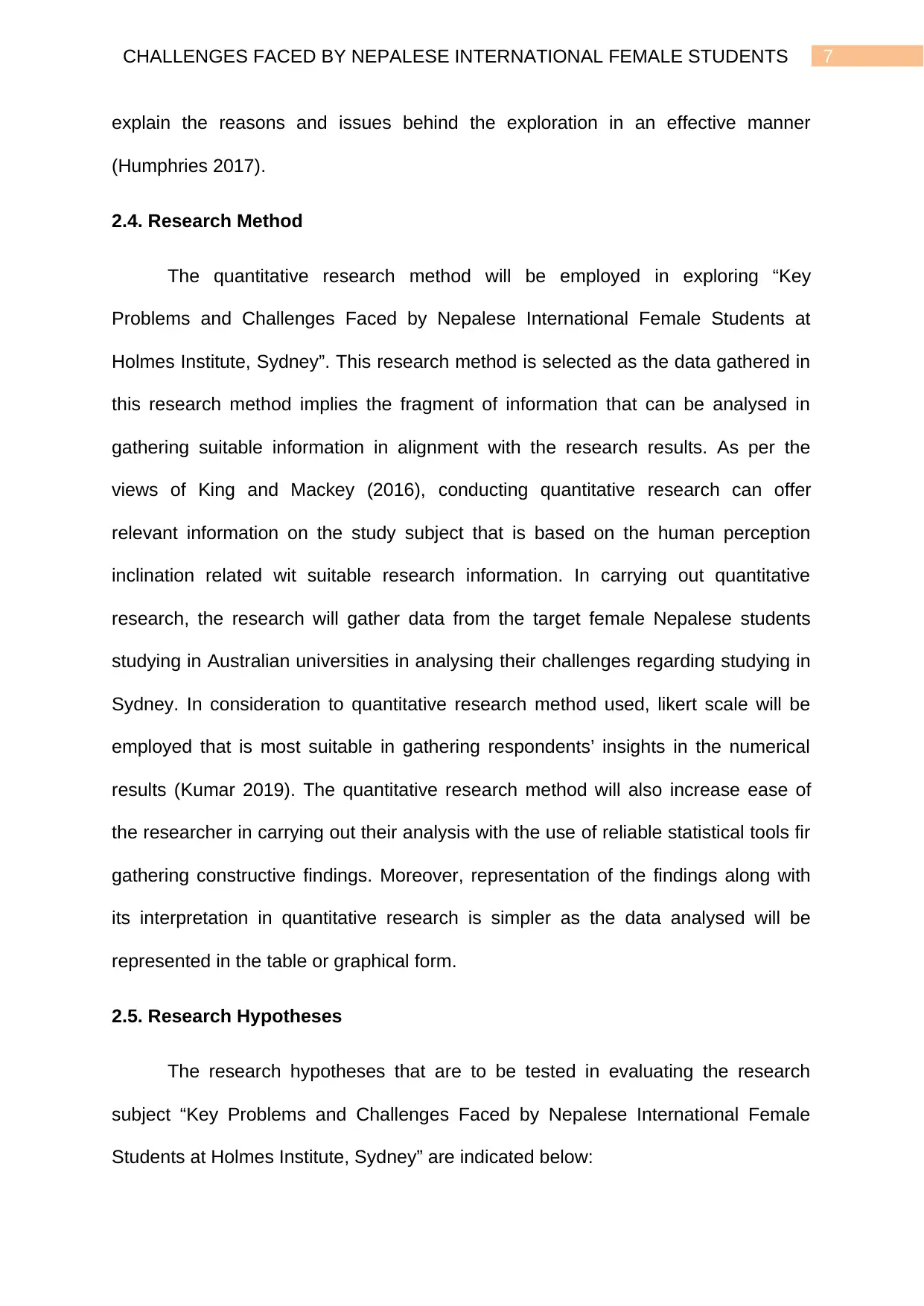
7CHALLENGES FACED BY NEPALESE INTERNATIONAL FEMALE STUDENTS
explain the reasons and issues behind the exploration in an effective manner
(Humphries 2017).
2.4. Research Method
The quantitative research method will be employed in exploring “Key
Problems and Challenges Faced by Nepalese International Female Students at
Holmes Institute, Sydney”. This research method is selected as the data gathered in
this research method implies the fragment of information that can be analysed in
gathering suitable information in alignment with the research results. As per the
views of King and Mackey (2016), conducting quantitative research can offer
relevant information on the study subject that is based on the human perception
inclination related wit suitable research information. In carrying out quantitative
research, the research will gather data from the target female Nepalese students
studying in Australian universities in analysing their challenges regarding studying in
Sydney. In consideration to quantitative research method used, likert scale will be
employed that is most suitable in gathering respondents’ insights in the numerical
results (Kumar 2019). The quantitative research method will also increase ease of
the researcher in carrying out their analysis with the use of reliable statistical tools fir
gathering constructive findings. Moreover, representation of the findings along with
its interpretation in quantitative research is simpler as the data analysed will be
represented in the table or graphical form.
2.5. Research Hypotheses
The research hypotheses that are to be tested in evaluating the research
subject “Key Problems and Challenges Faced by Nepalese International Female
Students at Holmes Institute, Sydney” are indicated below:
explain the reasons and issues behind the exploration in an effective manner
(Humphries 2017).
2.4. Research Method
The quantitative research method will be employed in exploring “Key
Problems and Challenges Faced by Nepalese International Female Students at
Holmes Institute, Sydney”. This research method is selected as the data gathered in
this research method implies the fragment of information that can be analysed in
gathering suitable information in alignment with the research results. As per the
views of King and Mackey (2016), conducting quantitative research can offer
relevant information on the study subject that is based on the human perception
inclination related wit suitable research information. In carrying out quantitative
research, the research will gather data from the target female Nepalese students
studying in Australian universities in analysing their challenges regarding studying in
Sydney. In consideration to quantitative research method used, likert scale will be
employed that is most suitable in gathering respondents’ insights in the numerical
results (Kumar 2019). The quantitative research method will also increase ease of
the researcher in carrying out their analysis with the use of reliable statistical tools fir
gathering constructive findings. Moreover, representation of the findings along with
its interpretation in quantitative research is simpler as the data analysed will be
represented in the table or graphical form.
2.5. Research Hypotheses
The research hypotheses that are to be tested in evaluating the research
subject “Key Problems and Challenges Faced by Nepalese International Female
Students at Holmes Institute, Sydney” are indicated below:
Paraphrase This Document
Need a fresh take? Get an instant paraphrase of this document with our AI Paraphraser
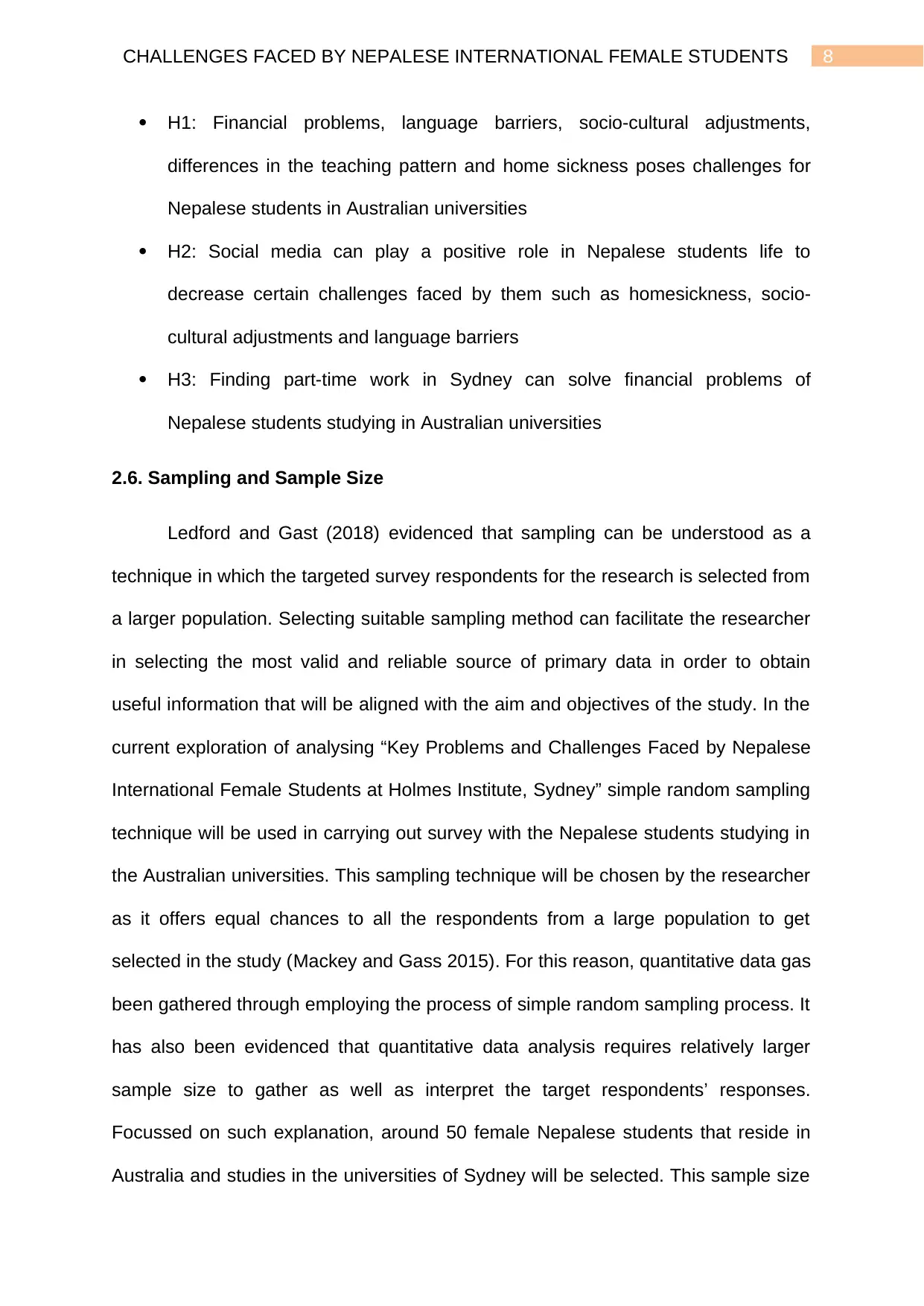
8CHALLENGES FACED BY NEPALESE INTERNATIONAL FEMALE STUDENTS
H1: Financial problems, language barriers, socio-cultural adjustments,
differences in the teaching pattern and home sickness poses challenges for
Nepalese students in Australian universities
H2: Social media can play a positive role in Nepalese students life to
decrease certain challenges faced by them such as homesickness, socio-
cultural adjustments and language barriers
H3: Finding part-time work in Sydney can solve financial problems of
Nepalese students studying in Australian universities
2.6. Sampling and Sample Size
Ledford and Gast (2018) evidenced that sampling can be understood as a
technique in which the targeted survey respondents for the research is selected from
a larger population. Selecting suitable sampling method can facilitate the researcher
in selecting the most valid and reliable source of primary data in order to obtain
useful information that will be aligned with the aim and objectives of the study. In the
current exploration of analysing “Key Problems and Challenges Faced by Nepalese
International Female Students at Holmes Institute, Sydney” simple random sampling
technique will be used in carrying out survey with the Nepalese students studying in
the Australian universities. This sampling technique will be chosen by the researcher
as it offers equal chances to all the respondents from a large population to get
selected in the study (Mackey and Gass 2015). For this reason, quantitative data gas
been gathered through employing the process of simple random sampling process. It
has also been evidenced that quantitative data analysis requires relatively larger
sample size to gather as well as interpret the target respondents’ responses.
Focussed on such explanation, around 50 female Nepalese students that reside in
Australia and studies in the universities of Sydney will be selected. This sample size
H1: Financial problems, language barriers, socio-cultural adjustments,
differences in the teaching pattern and home sickness poses challenges for
Nepalese students in Australian universities
H2: Social media can play a positive role in Nepalese students life to
decrease certain challenges faced by them such as homesickness, socio-
cultural adjustments and language barriers
H3: Finding part-time work in Sydney can solve financial problems of
Nepalese students studying in Australian universities
2.6. Sampling and Sample Size
Ledford and Gast (2018) evidenced that sampling can be understood as a
technique in which the targeted survey respondents for the research is selected from
a larger population. Selecting suitable sampling method can facilitate the researcher
in selecting the most valid and reliable source of primary data in order to obtain
useful information that will be aligned with the aim and objectives of the study. In the
current exploration of analysing “Key Problems and Challenges Faced by Nepalese
International Female Students at Holmes Institute, Sydney” simple random sampling
technique will be used in carrying out survey with the Nepalese students studying in
the Australian universities. This sampling technique will be chosen by the researcher
as it offers equal chances to all the respondents from a large population to get
selected in the study (Mackey and Gass 2015). For this reason, quantitative data gas
been gathered through employing the process of simple random sampling process. It
has also been evidenced that quantitative data analysis requires relatively larger
sample size to gather as well as interpret the target respondents’ responses.
Focussed on such explanation, around 50 female Nepalese students that reside in
Australia and studies in the universities of Sydney will be selected. This sample size
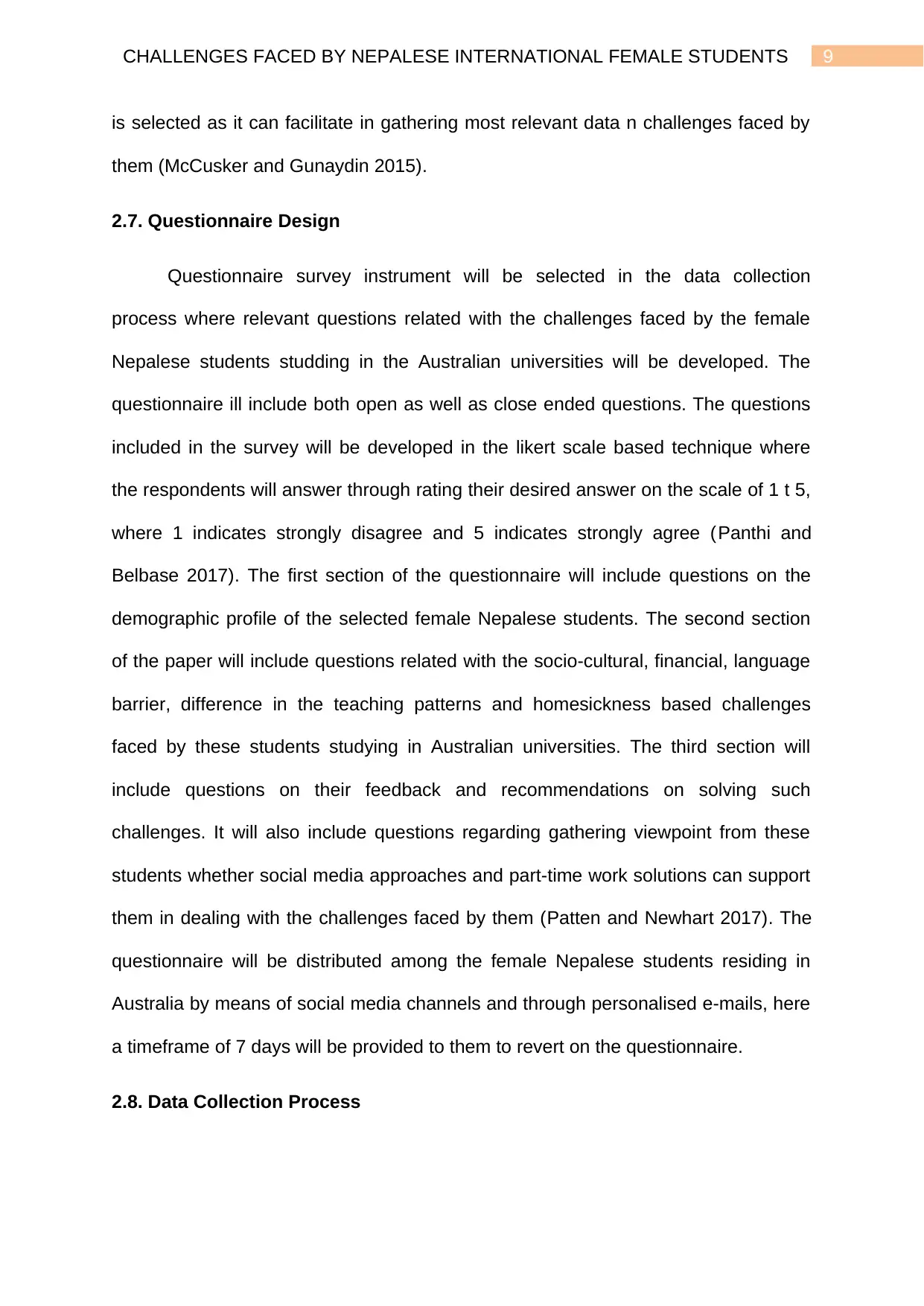
9CHALLENGES FACED BY NEPALESE INTERNATIONAL FEMALE STUDENTS
is selected as it can facilitate in gathering most relevant data n challenges faced by
them (McCusker and Gunaydin 2015).
2.7. Questionnaire Design
Questionnaire survey instrument will be selected in the data collection
process where relevant questions related with the challenges faced by the female
Nepalese students studding in the Australian universities will be developed. The
questionnaire ill include both open as well as close ended questions. The questions
included in the survey will be developed in the likert scale based technique where
the respondents will answer through rating their desired answer on the scale of 1 t 5,
where 1 indicates strongly disagree and 5 indicates strongly agree (Panthi and
Belbase 2017). The first section of the questionnaire will include questions on the
demographic profile of the selected female Nepalese students. The second section
of the paper will include questions related with the socio-cultural, financial, language
barrier, difference in the teaching patterns and homesickness based challenges
faced by these students studying in Australian universities. The third section will
include questions on their feedback and recommendations on solving such
challenges. It will also include questions regarding gathering viewpoint from these
students whether social media approaches and part-time work solutions can support
them in dealing with the challenges faced by them (Patten and Newhart 2017). The
questionnaire will be distributed among the female Nepalese students residing in
Australia by means of social media channels and through personalised e-mails, here
a timeframe of 7 days will be provided to them to revert on the questionnaire.
2.8. Data Collection Process
is selected as it can facilitate in gathering most relevant data n challenges faced by
them (McCusker and Gunaydin 2015).
2.7. Questionnaire Design
Questionnaire survey instrument will be selected in the data collection
process where relevant questions related with the challenges faced by the female
Nepalese students studding in the Australian universities will be developed. The
questionnaire ill include both open as well as close ended questions. The questions
included in the survey will be developed in the likert scale based technique where
the respondents will answer through rating their desired answer on the scale of 1 t 5,
where 1 indicates strongly disagree and 5 indicates strongly agree (Panthi and
Belbase 2017). The first section of the questionnaire will include questions on the
demographic profile of the selected female Nepalese students. The second section
of the paper will include questions related with the socio-cultural, financial, language
barrier, difference in the teaching patterns and homesickness based challenges
faced by these students studying in Australian universities. The third section will
include questions on their feedback and recommendations on solving such
challenges. It will also include questions regarding gathering viewpoint from these
students whether social media approaches and part-time work solutions can support
them in dealing with the challenges faced by them (Patten and Newhart 2017). The
questionnaire will be distributed among the female Nepalese students residing in
Australia by means of social media channels and through personalised e-mails, here
a timeframe of 7 days will be provided to them to revert on the questionnaire.
2.8. Data Collection Process
⊘ This is a preview!⊘
Do you want full access?
Subscribe today to unlock all pages.

Trusted by 1+ million students worldwide
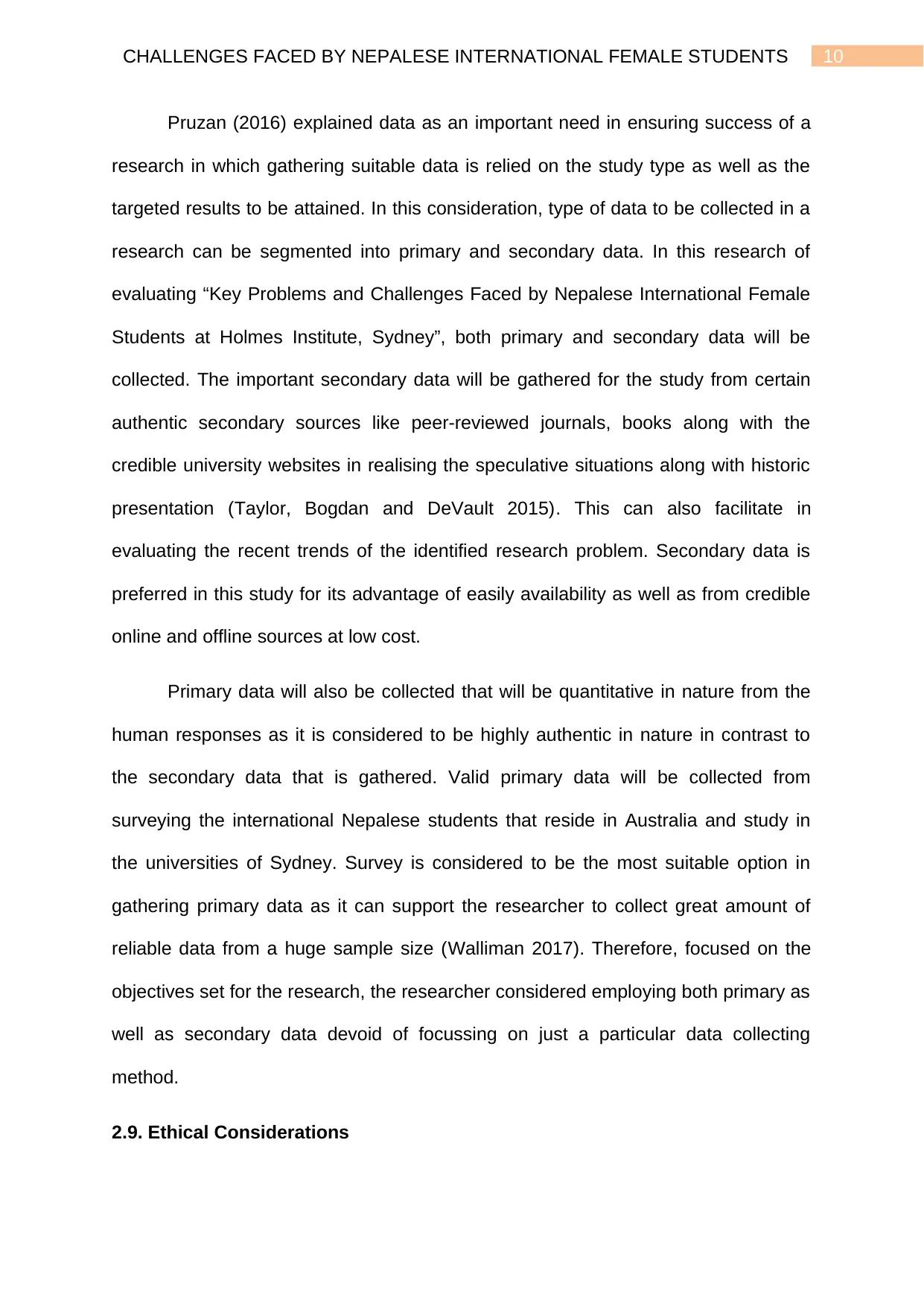
10CHALLENGES FACED BY NEPALESE INTERNATIONAL FEMALE STUDENTS
Pruzan (2016) explained data as an important need in ensuring success of a
research in which gathering suitable data is relied on the study type as well as the
targeted results to be attained. In this consideration, type of data to be collected in a
research can be segmented into primary and secondary data. In this research of
evaluating “Key Problems and Challenges Faced by Nepalese International Female
Students at Holmes Institute, Sydney”, both primary and secondary data will be
collected. The important secondary data will be gathered for the study from certain
authentic secondary sources like peer-reviewed journals, books along with the
credible university websites in realising the speculative situations along with historic
presentation (Taylor, Bogdan and DeVault 2015). This can also facilitate in
evaluating the recent trends of the identified research problem. Secondary data is
preferred in this study for its advantage of easily availability as well as from credible
online and offline sources at low cost.
Primary data will also be collected that will be quantitative in nature from the
human responses as it is considered to be highly authentic in nature in contrast to
the secondary data that is gathered. Valid primary data will be collected from
surveying the international Nepalese students that reside in Australia and study in
the universities of Sydney. Survey is considered to be the most suitable option in
gathering primary data as it can support the researcher to collect great amount of
reliable data from a huge sample size (Walliman 2017). Therefore, focused on the
objectives set for the research, the researcher considered employing both primary as
well as secondary data devoid of focussing on just a particular data collecting
method.
2.9. Ethical Considerations
Pruzan (2016) explained data as an important need in ensuring success of a
research in which gathering suitable data is relied on the study type as well as the
targeted results to be attained. In this consideration, type of data to be collected in a
research can be segmented into primary and secondary data. In this research of
evaluating “Key Problems and Challenges Faced by Nepalese International Female
Students at Holmes Institute, Sydney”, both primary and secondary data will be
collected. The important secondary data will be gathered for the study from certain
authentic secondary sources like peer-reviewed journals, books along with the
credible university websites in realising the speculative situations along with historic
presentation (Taylor, Bogdan and DeVault 2015). This can also facilitate in
evaluating the recent trends of the identified research problem. Secondary data is
preferred in this study for its advantage of easily availability as well as from credible
online and offline sources at low cost.
Primary data will also be collected that will be quantitative in nature from the
human responses as it is considered to be highly authentic in nature in contrast to
the secondary data that is gathered. Valid primary data will be collected from
surveying the international Nepalese students that reside in Australia and study in
the universities of Sydney. Survey is considered to be the most suitable option in
gathering primary data as it can support the researcher to collect great amount of
reliable data from a huge sample size (Walliman 2017). Therefore, focused on the
objectives set for the research, the researcher considered employing both primary as
well as secondary data devoid of focussing on just a particular data collecting
method.
2.9. Ethical Considerations
Paraphrase This Document
Need a fresh take? Get an instant paraphrase of this document with our AI Paraphraser

11CHALLENGES FACED BY NEPALESE INTERNATIONAL FEMALE STUDENTS
In carrying out research on “Key Problems and Challenges Faced by
Nepalese International Female Students at Holmes Institute, Sydney”, the research
will take into account abiding by necessary research code of conduct in
accomplishing all the tasks associated with the process of data collection. In
sustaining the ethical consideration of the research, the reasechers will consider
collecting secondary data from various valid sources that can provide authentic data
in ensuring the trustworthiness of the research results (Taylor, Bogdan and DeVault
2015). Whole collecting responses on the major challenges faced by the Nepalese
students in Australian universities, the researcher will also avoid asking delicate
questions in the questionnaire survey. Moreover, mutual consent will be gathered
from the selected respondents before persuading them to take part in the survey.
They will also be made aware of the research implications of such survey and use of
such survey responses in gathering study findings. In addition, the identity if the
respondents will also be kept confidential and will not be revoked because of several
sanctuary reasons (Taylor, Bogdan and DeVault 2015). The reasechers will
ascertain that the completion of this study will be sole work of him and will not
include any plagiarised content. Moreover, the researcher will also not entertain any
business use of the research statement.
2.10. Data Analysis
The data gathered in analysing “Key Problems and Challenges Faced by
Nepalese International Female Students at Holmes Institute, Sydney” will be
analysed through employing suitable statistical analytical methods. In consideration
to same, proper selection of the statistical analytical methods is important in order to
arrive at reliable and needed research outcomes. Implementation of the reliable
statistical tool SPSS is considered suitable for analysing the impact intensity of
In carrying out research on “Key Problems and Challenges Faced by
Nepalese International Female Students at Holmes Institute, Sydney”, the research
will take into account abiding by necessary research code of conduct in
accomplishing all the tasks associated with the process of data collection. In
sustaining the ethical consideration of the research, the reasechers will consider
collecting secondary data from various valid sources that can provide authentic data
in ensuring the trustworthiness of the research results (Taylor, Bogdan and DeVault
2015). Whole collecting responses on the major challenges faced by the Nepalese
students in Australian universities, the researcher will also avoid asking delicate
questions in the questionnaire survey. Moreover, mutual consent will be gathered
from the selected respondents before persuading them to take part in the survey.
They will also be made aware of the research implications of such survey and use of
such survey responses in gathering study findings. In addition, the identity if the
respondents will also be kept confidential and will not be revoked because of several
sanctuary reasons (Taylor, Bogdan and DeVault 2015). The reasechers will
ascertain that the completion of this study will be sole work of him and will not
include any plagiarised content. Moreover, the researcher will also not entertain any
business use of the research statement.
2.10. Data Analysis
The data gathered in analysing “Key Problems and Challenges Faced by
Nepalese International Female Students at Holmes Institute, Sydney” will be
analysed through employing suitable statistical analytical methods. In consideration
to same, proper selection of the statistical analytical methods is important in order to
arrive at reliable and needed research outcomes. Implementation of the reliable
statistical tool SPSS is considered suitable for analysing the impact intensity of
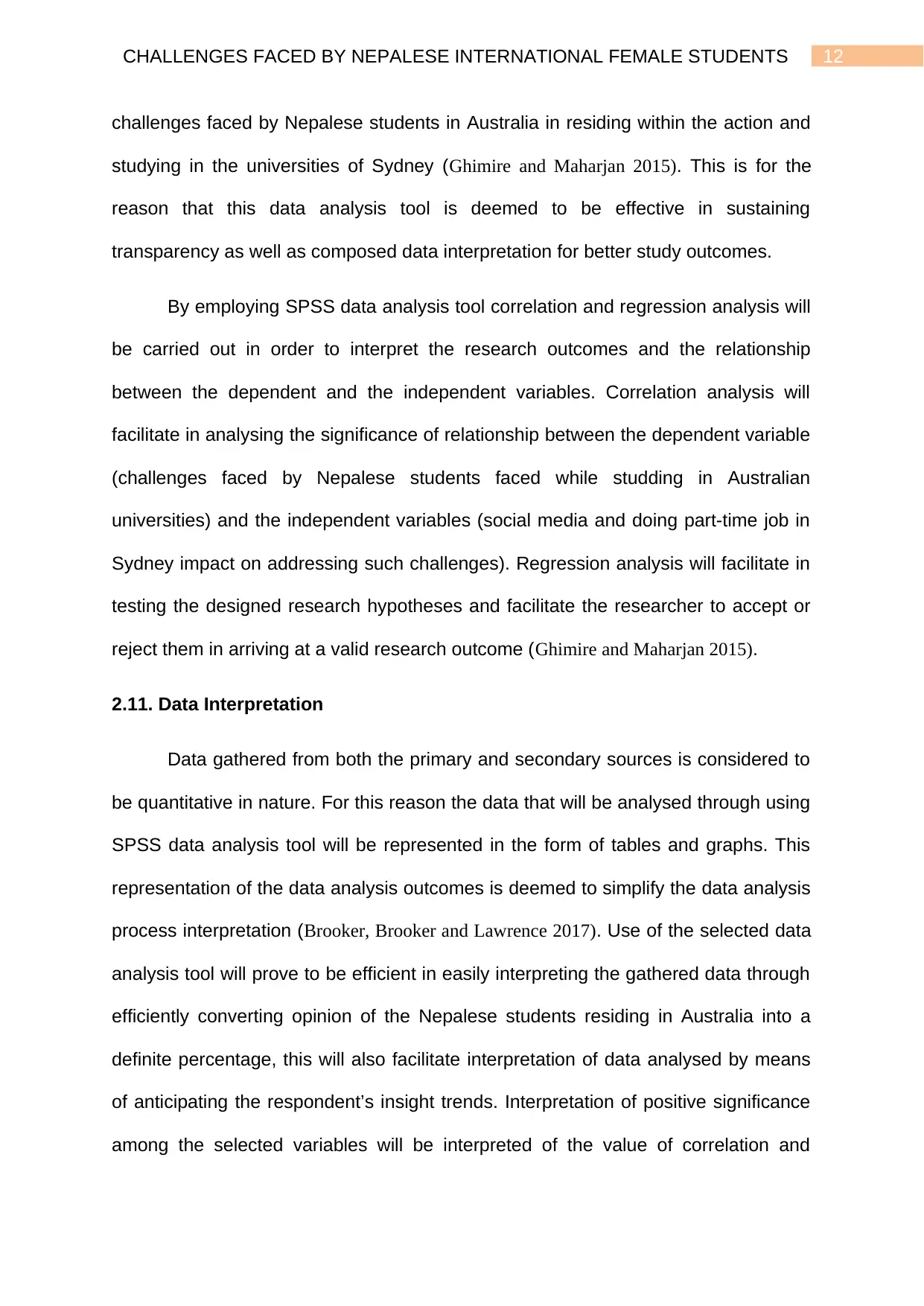
12CHALLENGES FACED BY NEPALESE INTERNATIONAL FEMALE STUDENTS
challenges faced by Nepalese students in Australia in residing within the action and
studying in the universities of Sydney (Ghimire and Maharjan 2015). This is for the
reason that this data analysis tool is deemed to be effective in sustaining
transparency as well as composed data interpretation for better study outcomes.
By employing SPSS data analysis tool correlation and regression analysis will
be carried out in order to interpret the research outcomes and the relationship
between the dependent and the independent variables. Correlation analysis will
facilitate in analysing the significance of relationship between the dependent variable
(challenges faced by Nepalese students faced while studding in Australian
universities) and the independent variables (social media and doing part-time job in
Sydney impact on addressing such challenges). Regression analysis will facilitate in
testing the designed research hypotheses and facilitate the researcher to accept or
reject them in arriving at a valid research outcome (Ghimire and Maharjan 2015).
2.11. Data Interpretation
Data gathered from both the primary and secondary sources is considered to
be quantitative in nature. For this reason the data that will be analysed through using
SPSS data analysis tool will be represented in the form of tables and graphs. This
representation of the data analysis outcomes is deemed to simplify the data analysis
process interpretation (Brooker, Brooker and Lawrence 2017). Use of the selected data
analysis tool will prove to be efficient in easily interpreting the gathered data through
efficiently converting opinion of the Nepalese students residing in Australia into a
definite percentage, this will also facilitate interpretation of data analysed by means
of anticipating the respondent’s insight trends. Interpretation of positive significance
among the selected variables will be interpreted of the value of correlation and
challenges faced by Nepalese students in Australia in residing within the action and
studying in the universities of Sydney (Ghimire and Maharjan 2015). This is for the
reason that this data analysis tool is deemed to be effective in sustaining
transparency as well as composed data interpretation for better study outcomes.
By employing SPSS data analysis tool correlation and regression analysis will
be carried out in order to interpret the research outcomes and the relationship
between the dependent and the independent variables. Correlation analysis will
facilitate in analysing the significance of relationship between the dependent variable
(challenges faced by Nepalese students faced while studding in Australian
universities) and the independent variables (social media and doing part-time job in
Sydney impact on addressing such challenges). Regression analysis will facilitate in
testing the designed research hypotheses and facilitate the researcher to accept or
reject them in arriving at a valid research outcome (Ghimire and Maharjan 2015).
2.11. Data Interpretation
Data gathered from both the primary and secondary sources is considered to
be quantitative in nature. For this reason the data that will be analysed through using
SPSS data analysis tool will be represented in the form of tables and graphs. This
representation of the data analysis outcomes is deemed to simplify the data analysis
process interpretation (Brooker, Brooker and Lawrence 2017). Use of the selected data
analysis tool will prove to be efficient in easily interpreting the gathered data through
efficiently converting opinion of the Nepalese students residing in Australia into a
definite percentage, this will also facilitate interpretation of data analysed by means
of anticipating the respondent’s insight trends. Interpretation of positive significance
among the selected variables will be interpreted of the value of correlation and
⊘ This is a preview!⊘
Do you want full access?
Subscribe today to unlock all pages.

Trusted by 1+ million students worldwide
1 out of 18
Related Documents
Your All-in-One AI-Powered Toolkit for Academic Success.
+13062052269
info@desklib.com
Available 24*7 on WhatsApp / Email
![[object Object]](/_next/static/media/star-bottom.7253800d.svg)
Unlock your academic potential
Copyright © 2020–2025 A2Z Services. All Rights Reserved. Developed and managed by ZUCOL.





